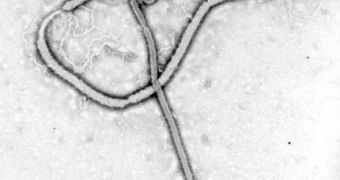Ebola is one of the most deadly viruses on the face of the Earth, and, although it has mostly been eradicated from most parts of the world, it still poses a threat of infection, if new strains appear. Researchers at the University of Texas Medical Branch in Galveston have recently taken the first steps towards creating an extraordinary new vaccine that can stop the viral agent, when they have discovered the two biochemical pathways that Ebola uses to infect its host cells. In their investigations of the two pathways, the researchers discovered what chemicals best stopped the spread, and applied them to the strain. The virus failed to infect more cell cultures after the treatment was applied.
This means that, if the results can be translated to humans as well, we could soon have the first complete treatment for the deadly disease, which affects its victims with severe and often fatal hemorrhagic fever. In some of the worst outbreaks recorded, the viral agent had a kill rate of over 90 percent, which means that most of the people who got it died shortly after. Additionally, Ebola outbreaks occur naturally (Uganda in 2008, the Democratic Republic of Congo in 2007), and are potentially very hazardous in the hands of bioterrorists.
Therefore, having a tool of ensuring that a potential infection can be stopped dead in its tracks, so to speak, is crucial. At the forefront of this struggle now sits the new research from Texas. “The premise for this work is that the virus is essentially nothing without a cell. It needs to rely on many cell proteins and factors for it to replicate. The idea is that if we can suppress the expression of those cell proteins for just a short time, we can then stop the disease in its tracks,” UTMB Microbiology and Immunology Associate Professor Robert Davey explains. He has been the leader of the research, and also the lead author of a new study detailing the find, appearing in the June issue of Drug Discovery Research.
For the experiments, the research team ran large-scale screening experiments, in which they injected small interfering RNA (siRNA) in over 735 different genes, coding the production of various types of proteins that might have aided the development of Ebola. Then, they infected the cultures with a special form of the disease, made of the viral proteins, seated on top of a nucleus taken from another virus. This made the final product safe enough to work with inside a normal lab, without extra security. “We got a number of hits, quite a lot of places where the virus wasn't infecting the cells. The problem was then to understand what those hits meant,” Davey adds.
Following the study, the PI3 kinase pathway and the CAMK2 pathway were identified as the most important for Ebola to multiply. After they were identified, the researchers found chemicals that interfered with their proteins, and moved their research in the UTMB BSL4 “spacesuit” lab, where they worked with the Ebola Zaire viral strain itself, the deadliest form of the virus in existence today.
“With the real virus in the BSL4, we found that the PI3 kinase inhibitor dropped virus titers by 65 percent, and if we used drugs which block CAMK2 function, it was just killed – stopped dead. This is really, very, very interesting because this pathway has a lot of potential for future pharmaceutical exploitation,” the expert concludes.

 14 DAY TRIAL //
14 DAY TRIAL //